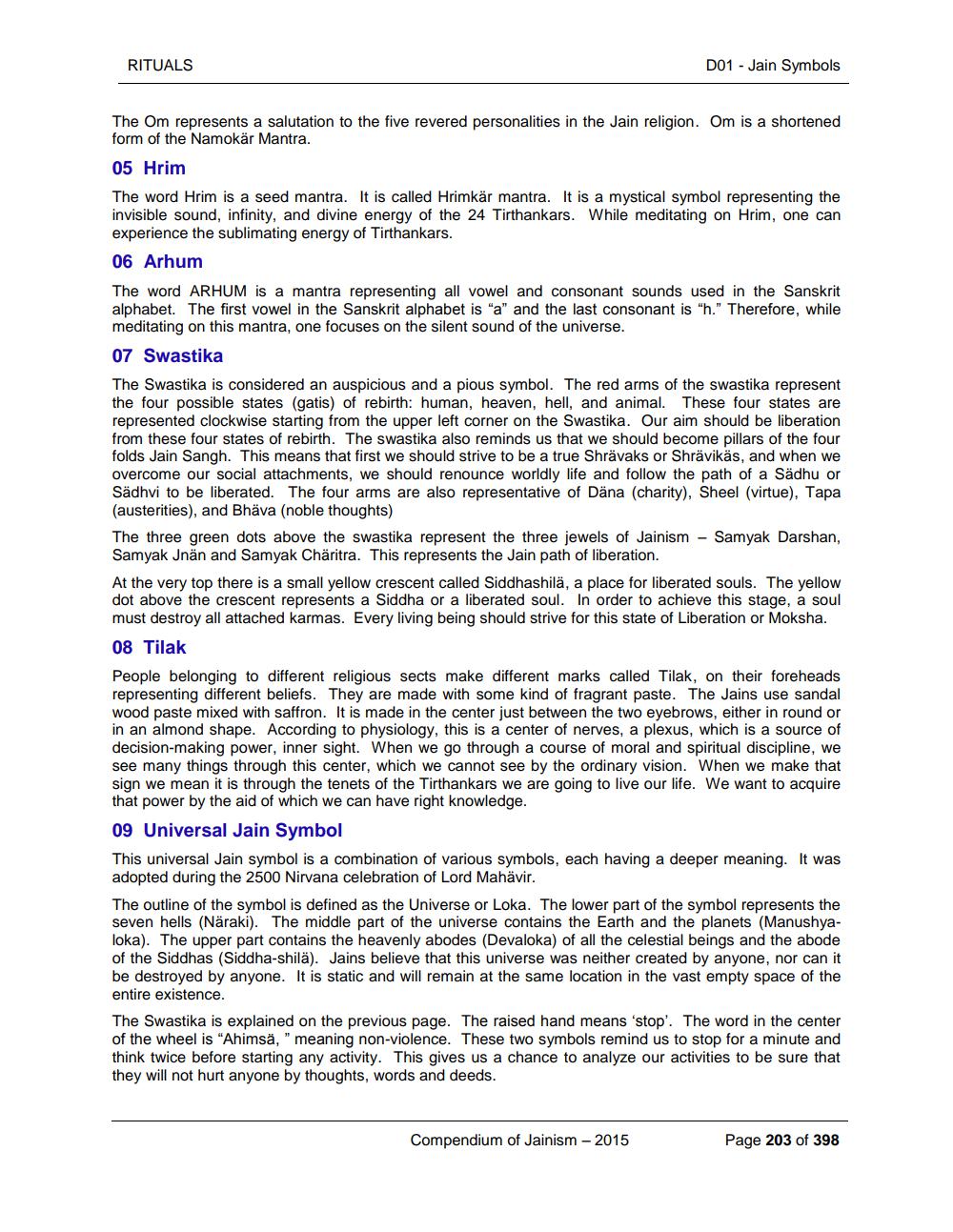________________
RITUALS
D01 - Jain Symbols
The Om represents a salutation to the five revered personalities in the Jain religion. Om is a shortened form of the Namokar Mantra. 05 Hrim The word Hrim is a seed mantra. It is called Hrimkär mantra. It is a mystical symbol representing the invisible sound, infinity, and divine energy of the 24 Tirthankars. While meditating on Hrim, one can experience the sublimating energy of Tirthankars. 06 Arhum
The word ARHUM is a mantra representing all vowel and consonant sounds used in the Sanskrit alphabet. The first vowel in the Sanskrit alphabet is "a" and the last consonant is "h." Therefore, while meditating on this mantra, one focuses on the silent sound of the universe.
07 Swastika The Swastika is considered an auspicious and a pious symbol. The red arms of the swastika represent the four possible states (gatis) of rebirth: human, heaven, hell, and animal. These four states are represented clockwise starting from the upper left corner on the Swastika. Our aim should be liberation from these four states of rebirth. The swastika also reminds us that we should become pillars of the four folds Jain Sangh. This means that first we should strive to be a true Shrävaks or Shrävikäs, and when we overcome our social attachments, we should renounce worldly life and follow the path of a Sädhu or Sadhvi to be liberated. The four arms are also representative of Däna (charity), Sheel (virtue), Tapa (austerities), and Bhäva (noble thoughts) The three green dots above the swastika represent the three jewels of Jainism - Samyak Darshan, Samyak Jnän and Samyak Charitra. This represents the Jain path of liberation. At the very top there is a small yellow crescent called Siddhashilä, a place for liberated souls. The yellow dot above the crescent represents a Siddha or a liberated soul. In order to achieve this stage, a soul must destroy all attached karmas. Every living being should strive for this state of Liberation or Moksha. 08 Tilak People belonging to different religious sects make different marks called Tilak, on their foreheads representing different beliefs. They are made with some kind of fragrant paste. The Jains use sandal wood paste mixed with saffron. It is made in the center just between the two eyebrows, either in round or in an almond shape. According to physiology, this is a center of nerves, a plexus, which is a source of decision-making power, inner sight. When we go through a course of moral and spiritual discipline, we see many things through this center, which we cannot see by the ordinary vision. When we make that sign we mean it is through the tenets of the Tirthankars we are going to live our life. We want to acquire that power by the aid of which we can have right knowledge. 09 Universal Jain Symbol This universal Jain symbol is a combination of various symbols, each having a deeper meaning. It was adopted during the 2500 Nirvana celebration of Lord Mahävir. The outline of the symbol is defined as the Universe or Loka. The lower part of the symbol represents the seven hells (Näraki). The middle part of the universe contains the Earth and the planets (Manushyaloka). The upper part contains the heavenly abodes (Devaloka) of all the celestial beings and the abode of the Siddhas (Siddha-shilä). Jains believe that this universe was neither created by anyone, nor can it be destroyed by anyone. It is static and will remain at the same location in the vast empty space of the entire existence. The Swastika is explained on the previous page. The raised hand means 'stop'. The word in the center of the wheel is "Ahimsä," meaning non-violence. These two symbols remind us to stop for a minute and think twice before starting any activity. This gives us a chance to analyze our activities to be sure that they will not hurt anyone by thoughts, words and deeds.
Compendium of Jainism - 2015
Page 203 of 398




